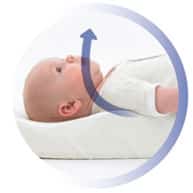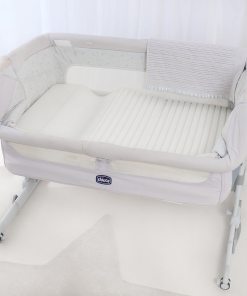SleepCurve Frequently Asked Questions
SleepCurve Baby Mattress Frequently Asked Questions
The following questions have come from a long list of questions posed by parents concerning Flat Head Syndrome and associated conditions, as well as the benefits of the SleepCurve Baby Mattress.
If you have a specific question not covered or answered here, please contact us and we will try to help.
Flat Head Syndrome is seen in babies and children caused by lying a baby on a flat mattress when the bones are still soft enough to deform.
It is currently thought that the bones are soft enough to deform before the age of 12 months.
Flat Head Syndrome (positional plagiocephaly) is caused by a baby having a preferred side to which to rotate.
After a period of time, with the weight of the baby’s head being consistently on one spot, the head starts to flatten thereby distorting the shape of the head.
It looks like the baby has a mis-shaped head.
There are plenty of photos to demonstrate a typical flat head in a baby, but the easiest way to look at the shape of a baby’s head is to look at it from above and observe the symmetry.
The key to treatment of Flat Head Syndrome is to catch it early enough for self correction to take place.
In order for this self correction to take place you must take away the cause, namely the flat mattress, bouncy chair or prolonged use of a car seat. By using a SleepCurve mattress this will take off the pressure from a baby’s skull bones and start to allow the self-correction process to take place.
Additionally there are helmets that can be fitted to babies which have the same effect of taking the pressure off the baby’s head.
Prevention is by never allowing your baby’s head to come into contact with a flat surface whilst on the back, hence the importance of a SleepCurve mattress.
Flat Head Syndrome usually starts within the first three months of the baby being born.
At least 2 pieces of published research suggest that children with positional plagiocephaly (flathead syndrome) do not do as well at school, both in the classroom as well as in the playground.
Avoiding Flat Head Syndrome is relatively easy.
Firstly be aware that the condition exists, secondly keep checking that the back of your baby’s head is the same on both sides.
Avoid the use of flat surfaces at the back of your baby’s head by using a sleepcurve mattress. Encourage tummy time.
Generally positioning doesn’t work.
Now here is the problem.
When a baby develops a flat spot on their head, on a standard flat mattress, gravity will tend to roll the head onto the flat part, thereby making the problem worse. If you try and position the baby’s head off the flat spot it will roll back on to the flat area.
A SleepCurve mattress will take away the pressures of a flat mattress even if the baby’s head rolls on to the flat spot.
Flat Head Syndrome (on one side of the head) starts usually when the baby has a preferred side to which to rotate.
When the head is constantly in the same position, a flat spot starts usually within the first three months.
Flat spots at the back of the head (Brachycephaly) start a little later.
There is a mixed evidence about this.
Flat Head Syndrome rarely corrects completely but does lessen as the baby starts to sit up for longer periods. Flat Head Syndrome my be more noticeable at bath time in children when the hair is flattened by the water.
Children who grow into adults with flat heads may find it more difficult to have their head shaved.
Flat Head Syndrome may be corrected if caught early enough.
The research carried out at a local children’s hospital found that if babies were placed on a SleepCurve mattress their flattened heads would improve and self-correct. The use of an expensive helmet can be avoided if caught early enough.
There is no known link to Flat Head Syndrome predisposing to autism.
The simple answer in ‘no’.
It is much more difficult to alter the skull shape when the bones have hardened and fused. Hence the reason why this must be caught and dealt with at an early stage.
No. Babies who tend to develop Flat Head Syndrome are those babies that are quiet and ‘good’ babies.
Cured is an absolute term. Flat Head Syndrome can be improved significantly to the point it becomes unrecognisable.
Cured is a term we use in relation to disease, and this is not a disease.
Parents don’t want their babies to look ‘odd’. They also want them to do well at school.
Research has found that children don’t do as well at school with Flat Head Syndrome.
No, there are no known dangers directly associated with Flat Head Syndrome.
The degree of Flat Head Syndrome may vary as the baby continues to develop Flat Head Syndrome and before the parents have spotted the syndrome.
As the baby starts to move and sit up unaided the severity tends to diminish but not disappear fully.
Flat Head Syndrome is more common in ‘good’ babies that don’t need picking up as much due to crying.
It is less common in countries in which the culture is to carry the babies for longer periods of time..
No. Siblings may or may not follow the pattern of their elder brother or sister.
The advice given by authorities is not to use pillows or positioners.
SleepCurve mattresses are neither a pillow or a positioner.
Many people treat or advise about Flat Head Syndrome, some more effectively than others.
Cranial osteopaths can usually help quickly with any head and neck rotation issues and help with head shape self-correction in conjunction with a SleepCurve mattress.
Helmets are sometimes used when the baby is a little older.
Once craniosynostosis has been discounted, Flat Head Syndrome can be diagnosed by looking at the baby’s head shape.
This cannot easily be done without surgery.
Flat Head Syndrome is not serious as far as it causing any medical issues or being life-threatening.
Flat Head Syndrome is regularly treated successfully by using a SleepCurve mattress which takes the pressure off the baby’s and allows self-correction to start to take place naturally.
Published research has discovered that children with positional plagiocephaly (or Flat Head Syndrome) do not do as well at school both in the classroom as well as in the playground.
There is no known link between Flat Head Syndrome being associated with speech delay.
Mis-shaped heads in new-borns (babies of less than a week old) is probably caused by either craniosynostosis (where skull bones fuse prematurely) or from pressure in the uterus or from the birth process itself.
It is relatively rare for babies to have Flat Head Syndrome until they have been placed on their back on a flat mattress thereby flattening the skull bones.
Torticollis means stiff neck (usually difficult to turn to one side or other).
This will result in the baby rotating to one side which will probably result in Flat Head Syndrome.
Premature babies are more likely to develop Flat Head Syndrome due to the fact that their heads are softer and their neck muscles that little bit weaker.
Babies who suffer from reflux may or may not have Flat Head Syndrome. Reflux happens in babies with or without Flat Head Syndrome.
Yes, Flat Head Syndrome is recognised by the NHS although it is not recognised as a medical condition, rather a cosmetic condition.
Yes, on one side at the back it is called plagiocephaly. Flat head at the back is called brachycephaly.
Craniosynostosis is an extremely rare form of mis-shaped head that needs a scan to diagnose.
Pillows and positioners are not recommended in cots for safety reasons. A Sleepcurve mattress is neither a pillow nor a positioner.
The Sleepcurve Mattress is proven to be effective..
Flat Head Syndrome starts in the first few weeks in a baby’s life. It can go on into childhood and remain to a degree for the rest of life.
Yes, in severe cases.
Flat Head Syndrome, if left unattended or untreated, progresses to be worse up to about 8 months. This is because gravity is rotating the head back on to the flat spot which is progressing the problem to become worse.
When you take steps to remove the pressure from a baby’s skull, by using a SleepCurve mattress, the skull will automatically start to slowly self-correct.
This depends on the severity and the age of the baby. The younger the baby the quicker the response. I like to see 1mm per week recovery in the diagonal difference in my clinic.
Yes, the effect of Flat Head Syndrome in adults is usually seen in teenagers who shave their heads.
Yes, on line, and the SleepCurve team would be happy to answer any of your questions or concerns about Flat Head Syndrome.
The only exercises that are sometimes useful for Flat Head Syndrome and its prevention are rotation exercises of the head and neck by stimulating movement each way to reduce any stiffness.
If the head shape is badly distorted and the eye sockets (orbits) are completely out of line then the visual acuity may be affected making hand to eye co-ordination more difficult. It has less of an impact on hearing.
Flattening at the back of the skull.
Babies will and do turn over. If they have the strength to do that they will not suffocate themselves either on a SleepCurve mattress nor a flat mattress. The curve of the mattress is shallow and there has never been a safety issue reported In fact over the many tens of thousands of mattresses sold to parents of babies there has never been a single safety incident reported let alone death.












